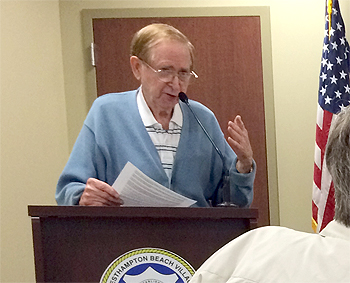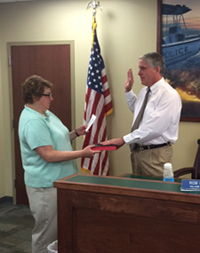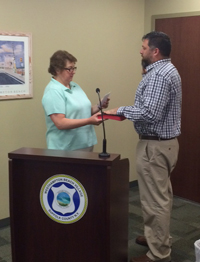The new board of Westhampton Beach, meeting for the first time last night, ended medical/dental benefits for trustees. It also heard 10-minutes by Jack O’Dwyer on the multi-million dollar threat posed by backers of an eruv Jewish religious boundary in WHB.
Taking office were Brian Tymann and Rob Rubio, WHB businesspeople who unseated two incumbents by calling for an end to benefits for trustees and by saying they were opposed to “the general concept of religious demarcations on public property.”
 Jack O'Dwyer speaks at the Westhampton Beach meeting on July 6. Photo by Debora Giammarco Jack O'Dwyer speaks at the Westhampton Beach meeting on July 6. Photo by Debora Giammarco |
Their stance on the eruv won the backing of Jewish People Opposed to the Eruv which urged its 300+ members to vote for them. The incumbents they unseated, Hank Tucker and Patricia DiBenedetto, were silent on the eruv issue.
Tucker was heading for a fifth two-year term which would have given him lifetime medical/dental benefits. Benefits are not being cancelled to previous trustees.
This reporter spoke for ten minutes following about 40 minutes of procedural matters such as the annual appointing of committees.
We warned that WHB, as well as Southampton and Quogue, are under threat of millions of dollars in penalties, court costs and legal fees of the East End Eruv Assn. if they lose the battle against eruvim.
Tenafly, N.J., after winning in the local Federal Court in 2001 but losing in the Appeals Court in 2002, had to pay the Tenafly Eruv Assn. more than $300,000 for the group’s legal costs.
Robert Sugarman, of Weil, Gotshal & Manges, was the lawyer for the Tenafly eruv group and is the lawyer for EEEA.
|
|
Whoppers Being Told
We told the 50 citizens who attended that our function, not only as a reporter but as a three-decade resident of WHB, is to nail any untruths or inaccuracies that are floated in the public’s field of vision.
Three whoppers present themselves topped by the claim, on the Hampton Synagogue website and elsewhere, that no court ever ruled against an eruv.
Judge William Bassler of the Federal District Court in New Jersey, in 2001 issued a 23,424-word decision saying Tenafly could not tolerate permanent lechi religious symbols on its utility poles and ordered them removed. The six trustees of Tenafly, including Mayor Ann Moscovitz, gave lengthy statements supporting that view.
That reasonable decision was overturned in 2002 by an unreasonable 16,981-word Appeals Court decision by Thomas Ambro. The court said Tenafly had allowed lost pet signs, colored ribbons by high school students, directional signs, and signs during the Christmas season and could not therefore stop the lechi markers of the Orthodox.
Appeals Court Trampled on Logic
The comparisons were inane and illogical. The Tenafly lechis were to be there permanently and had deep religious meaning. Consciously violating the ban against work on the Sabbath can result in the death penalty for an Orthodox person, according to the Yeshiva Museum. Involved here is heavy duty religious dogma.
Comparing lost pet signs to lechis was like comparing a bike to a car, an ant with an elephant, whatever. They’re not in the same league with each other.
The second whopper is that the Supreme Court has somehow seconded the 2002 Tenafly decision because it won’t take the issue. The court gets more than 2,000 proposed cases each year and accepts only a handful. Failure of it to take up the eruv separation of church and state issue means nothing.
The third whopper is that there is an eruv in Westhampton Beach as claimed on the Hampton Synagogue website. An eruv demands some sort of physical markers on utility poles, string of some sort or other physical objects, plus community acceptance.
|
|
None can be found in WHB. Community approval has never been obtained. Tymann and Rubio expressed opposition to religious symbols on utility poles before they were elected. Previous mayor Conrad Teller estimated 90-95% of residents were against the eruv.
Academics Put Shame to WHB and its Library
We told the meeting that it’s odd that Yale and Yeshiva Universities spent six months on presentations, exhibits and discussions about eruvim but WHB officials and its library cannot spend six minutes on the subject.
The onslaught by eruv proponents can be defeated by shedding light on it. It will melt away like butter under the sun. What the three towns need is an ongoing weekly program of educational events and exhibits similar to the six-month long program on the eruv conducted in the fall of 2012 and spring of 2013 by Yale and Yeshiva.
Libraries, dedicated to “lifelong learning,” are the logical place for this. The American Library Assn. is urging libraries to host public sessions on controversial topics since the web now dominates as a research tool.
Fighting this in court since 2011 has already cost Westhampton $125,118 in outside legal costs, and the Village, Southampton, Quogue and Jewish People against the Eruv more than $1 million. No end is in sight since the case is now mired in New York State Courts which are deciding whether Southampton can enforce its laws against signs on utility poles.
EEEA wants the federal lawsuits pursued with discovery, interrogatories, etc., without waiting for action by the state. Eruv costs are escalating, reported 27east.com Feb. 4.
 WHB trustees Rob Rubio, Charles Palmer and Mayor Maria Moore. WHB trustees Rob Rubio, Charles Palmer and Mayor Maria Moore. |
Southampton Complains of Costs
SH, which has spent $675,860 on outside legal costs, says it has no insurance. It says staff time on this has reached intolerable levels. Paperwork is more than a foot high. SH has branded it a “terrible waste of municipal resources.”
Virtually all of the events and exhibits of the Yale/Yeshiva series are on the web including this 20-minute video. Speaking Oct. 22, 2012 at Yale Law School was none other than Sugarman. His topic was “The Eruv Meets the First Amendment.” He does not respond to requests for the text.
What eruv proponents say to themselves about the eruv and what they say to the public and courts are two different things.
Lawsuits claim that an eruv allows believers to push and carry certain objects, But Yeshiva president Richard Joel told an eruv panel: “It (the eruv) was never meant, boy, now we can carry. [it meant] now we’re a neighborhood, we’re a neighborhood that can function as a neighborhood. The concept of an eruv is such a beautiful one because what it says is that we can use law to provoke a sense of extended family and a sense of community.”
Synagogues in the U.S., including the Hampton Synagogue, display a map on their websites showing the area claimed as their “home.” There are extensive descriptions of what an eruv is—the conversion of public space into private space.
The web has invalidated all court decisions to date that support the legitimacy of an eruv because it shows eruv maps and explains what an eruv is in detail.
The Westhampton website has a link to eruv court filings but the latest entry is Dec. 22, 2014. It should provide the 6,000-word discussion conducted by Judge Kathleen Tomlinson in Islip Feb. 24. Link to it is here.




 Husch Blackwell Strategies has added FleishmanHillard alum Michael Slatin as a principal in its public affairs group.
Husch Blackwell Strategies has added FleishmanHillard alum Michael Slatin as a principal in its public affairs group. Rory Cooper, a veteran Republican operative and policy specialist, has joined Teneo’s Washington office as senior managing director in its strategy & communications practice.
Rory Cooper, a veteran Republican operative and policy specialist, has joined Teneo’s Washington office as senior managing director in its strategy & communications practice. Brian Fallon, who served as national press secretary for Hillary Clinton’s 2016 presidential run, is signing on next month as Vice President’s Kamala Harris’ campaign communications director.
Brian Fallon, who served as national press secretary for Hillary Clinton’s 2016 presidential run, is signing on next month as Vice President’s Kamala Harris’ campaign communications director. TikTok is nothing more than a Chinese propaganda tool that poses “a grave threat to America’s national security and, in particular, impressionable children and young adults,” say two Congressmen who want the platform registered as a foreign agent.
TikTok is nothing more than a Chinese propaganda tool that poses “a grave threat to America’s national security and, in particular, impressionable children and young adults,” say two Congressmen who want the platform registered as a foreign agent. Public Strategies Washington has added Abbie Sorrendino, a former aide to now Senate Majority Leader Chuck Schumer.
Public Strategies Washington has added Abbie Sorrendino, a former aide to now Senate Majority Leader Chuck Schumer.


 Have a comment? Send it to
Have a comment? Send it to 
No comments have been submitted for this story yet.